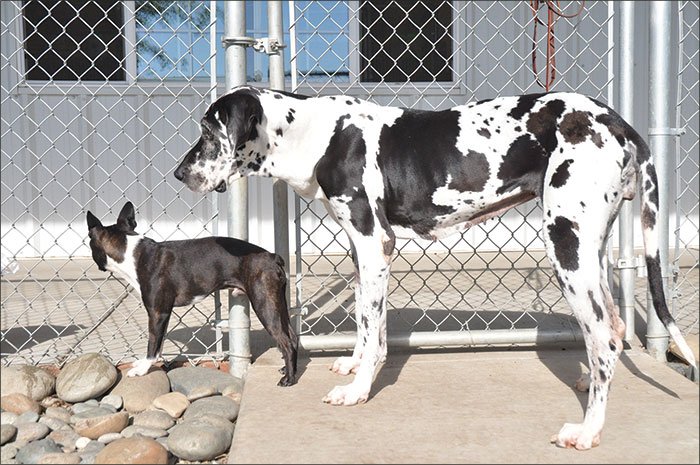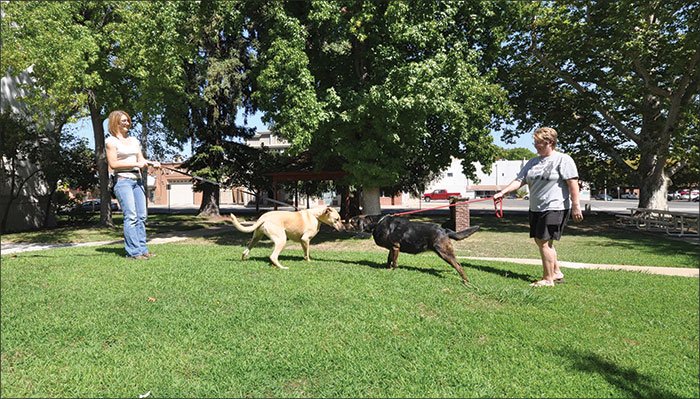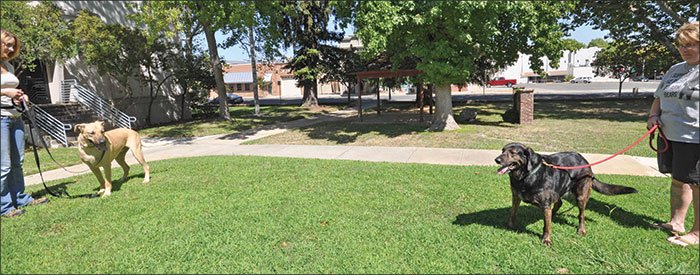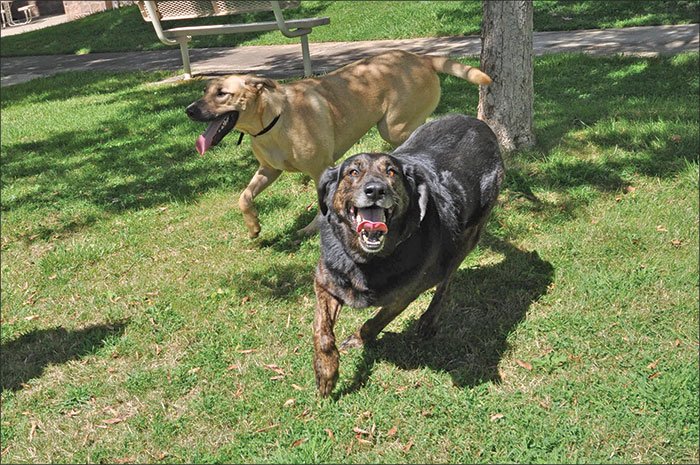We currently have three dogs. We lost our Scottie a few months ago to cancer, and our Australian Shepherd last year to old age and failing health. This is the fewest number of dogs we’ve had in our family for as far back as I care to remember, and while I grieve Missy and Dubhy’s absence every day, a part of me feels some guilty relief that the canine chaos and caretaking load has lightened somewhat. Still, while I know it won’t be for a while yet, another part of me contemplates the next potential pup-addition to the Miller pack . . . which leads me to contemplate the complexities and challenges of bringing home a new dog.

However, as much as you would like to run out and go look in shelters and at online photos of candidates being fostered by rescue groups, you should consider some other individuals – namely, the dog (or dogs) you may already have at home, and your human family or housemates.
A dog for the dog?
Lots of dog owners are convinced they are getting another dog, at least in part, as a companion for the current dog – or dogs. Don’t kid yourself on this one. While some dogs do enjoy the company of their own kind, many would just as soon not share their beds, bones, and humans’ attention with another canine resident. Be clear that if you are getting another dog, you are getting it for yourself (or for other human family members), and it’s an added bonus if your current dog and the new one end up becoming bosom buddies.
A couple of years ago, Scooter, our now-13-year-old Pomeranian, made it quite clear he wasn’t in favor of adding any more dogs to our family; the presence of our most recent foster, a high-energy young Terrier mix, elicited a bout of hemorrhagic gastroenteritis (yes, it’s as bad as it sounds) in the older dog. Cricket wasn’t even living in the house – he was kenneled in the training center and joined us for barn chores and hikes around the farm, but even that was enough to cause Scooter’s severe stress-induced gastrointestinal disaster. Cricket had to be dismissed from barn duty, while Scooter opted out of the hikes. Scooter now also suffers from a collapsing trachea, another life-threatening condition (common in small dogs) that is exacerbated by stress, so a new Miller dog is definitely out of the question for the time being.
Scooter aside, our 11-year-old Lucy (Cardigan Welsh Corgi) and 10-year-old Bonnie (Scorgidoodle) might tolerate a canine addition, but neither one is begging for a puppy for Christmas. They are tolerant of doggie visitors to the farm, but are happier keeping to themselves if given the choice. Lucy has never been one for sharing with other dogs anyway, and her well-managed resource-guarding tendencies don’t need the stress of a new canine competitor.
Evaluate your own home dogs before blithely adopting another. Do they welcome canine visitors with open paws? In that case, your wise selection of a new furry family member should go relatively smoothly, especially if you do careful introductions. If, however, they are less than enthusiastic about entertaining visiting dogs, know that if you chose to increase your hound numbers, at best it may take some skillful orchestration to create a harmonious household, and at worst you could be creating a nightmare.
The people’s choice
You also need to make sure all your human family members are in favor of adding another dog to the group. It’s not fair to your dogs to put them in the center of controversy if one or more family members are opposed to the idea. You will need the enthusiastic support of all household members to ensure you won’t be pushed by inter-family drama to return the new dog to the shelter. That’s not fair to anyone, least of all the dog.
Think It Through
If you decide that your dog (or dogs) and family are all ready to bring another dog into the mix, consider these additional factors as you start your adoption search:

Size of the new dog – This is not an absolute, but think carefully before setting up a multi-dog family made up on individuals with a significant size or substance disparity. Scooter, at 12 pounds, lived happily with 45-pound Missy – but Missy was eight years old when we adopted her, well past those puppy or adolescent bursts of energy that might have stressed or injured the smaller dog. The greater the size difference, the greater the possibility that the smaller dog might get hurt, either during too-rough play, a dog-on-dog altercation, or even in a tragic moment of predatory drift (in which the larger dog suddenly perceives the smaller running dog as a prey animal such as a rabbit or a cat and chases or grabs it).
Age – It’s true that a mature dog can be rejuvenated by the addition of young-dog energy. It’s also true that a high-energy youngster can make life miserable for the senior dog who just wants to lie on his rug in the sun and enjoy his golden years in peace and quiet. There are lots of homeless adult dogs in shelters and rescue groups, so if you have older dogs already at home, consider adopting another senior or at least middle-aged dog, rather than subjecting your old-timer dogs to puppy biting and body-slamming.
If you do opt for a younger dog, then you owe it to your seniors to protect them from the unwanted attentions of a pesky puppy. Also, if required to defend themselves from unwanted puppy persistence, older dogs can become defensively aggressive, and teach the puppy to become aggressive in return. So, find an appropriate playmate for the youngster, one who appreciates endless games of high-speed-chase-around-the-yard, and manage your home environment with closed doors, tethers, crates, exercise pens, and baby gates to maintain the domestic tranquility.
Personality –Take your dog’s (or dogs’) personality quirks and traits into account, and try to adopt a new dog with a personality that will mesh well. Our Lucy is a very assertive, possessive herding dog, while Bonnie is super soft and appeasing. They do well together. Bringing another assertive dog into the mix could spell trouble; there would likely be serious clashes with Lucy.
And don’t discount your own personality! If you have a Bonnie-style soft and deferent home-dog, bringing a bossy Lucy-type dog into the family could be upsetting to you – as you see your sweetheart getting pushed around by the newcomer (even if the sweetie doesn’t seem to mind). If you already have one dog who is a real attention hog, you might take pains to adopt one who isn’t so needy, so they aren’t trying to push each other off the sofa to snuggle with you. If you have a dog who is sound-sensitive, avoid adopting a dog with a strong propensity to bark. You get the idea!
Play Styles – Energy levels aside, different dogs have different play styles. Some like to play chase, some like to wrestle and do “chew-face.” Some are body slammers, while others eschew physical contact. Some like to dance around the action and cheerlead, while others are “fun police,” trying to break up the action if two or more dogs are playing roughly. Your prospects for pack harmony are much greater if you look for a new addition with a play style that is compatible with one or more of your current dogs.
Gender –This can get tricky. The world over, there are male dogs who get along with males and females, sterilized or not, and females who get along with both genders, sterilized or not. Yet many rescues and shelters flat out refuse to adopt a female to a home where there is another female, on the supposition that female dogs can’t get along.

Hogwash! . . . to a point. For the past 30-plus years, my husband and I have had three to five dogs at a time, all combinations of genders (albeit all spayed and neutered), and for the most part they’ve gotten along beautifully. That said, when there are problems, conflicts between females tend to be more intense, longer-lasting, and harder to manage and or modify than male-male or male-female problems. Even in our own household, the most challenging relationship we’ve had was between Lucy and Missy. Still, this seems like a poor reason to rule out all female-female adoptions. If you have a difficult female at home, then, yes, a male is probably a better choice. Absent that, take it on a case-by-case basis and look for a dog who is compatible with your dog(s), regardless of gender.
Breed –Breed doesn’t matter much, other than taking breed propensities into consideration as you consider the previously listed factors (Labs tend to be high-energy body-slammers; the herding breeds tend to dislike other dogs getting in their space; St. Bernards are large; Chihuahuas are small, etc.). The individual’s personality is more relevant than the breed propensity, because there are Labradors who are soft and gentle, and you can find Border Collies who are happy to share their space. You may have breed or breed-mix preferences yourself, and that’s just fine – by all means, indulge. But don’t rule out a dog on the basis of breed norm alone; sometimes, the candidate in question is the outlier.

Careful Introductions
So you’re taking the plunge. You really want another dog and you’ve decided your current dog-loving canine pal(s) really would appreciate a companion – or will at least tolerate an addition with reasonable good graces. You’ve picked out a dog at your local shelter and done initial introductions there that went well. You’re ready to bring the new family member home. The way you do so can make or break future relations between the newcomer and your home dogs.
First, make sure all dogs are well exercised before they meet. Take your current dogs for a good hike in the woods, or a run at the dog park, or at least play a good solid round of tennis ball or Frisbee before you go to fetch the newbie. If you live in the city and don’t have access to woods, dog parks, or fenced yards, do whatever serves for exercise for your dog(s): jogging on the treadmill, chasing a toy down the hallway, or jumping over broomsticks in the living room.
Next, arrange to do introductions one at a time. Allowing multiple dogs to mob the new one can literally scare the pee out of him, and the trauma can damage his future relationships with the group. My preference is a neutral fenced yard, but absent that, your own yard will serve the purpose.
It’s is hugely helpful to do introductions outdoors; indoors, your new dog can feel trapped, and your home dogs are more likely to feel possessive or territorial. If you don’t have a yard, find a friend who does, or arrange to borrow some other neutral space. You may be able to set up the meet and greet at your favorite dog professional’s training facility – and get some expert guidance as well.

Dog Introduction Scenario #1 – All Goes Smoothly
Position one of your current dogs at the far side of the yard, on leash, with the leash held by a reasonably knowledgeable dog person, and your other dogs where they can’t see/won’t get aroused by the sight of a new dog. I like to start with the dog whom I think will be the easiest and friendliest, to build confidence in all participants.
Bring the new dog into the gate, on leash. Let the dogs see each other, and calmly approach. If one or both get aroused, stop and encourage them to settle and relax before coming closer. You may need to use high-value treats to get them to think about something other than the exciting presence of the other dog.
As long as their body language looks affiliative (i.e., friendly, “I’d like to get to know you!”) and the dogs are reasonably calm, continue closing the distance between them until they are eight to ten feet apart.
Assuming both dogs still look friendly and happy, drop both leashes and let them meet. Dropping the leashes allows the dogs to meet and interact naturally, increasing the likelihood of a positive interaction. Leashes held by humans interfere with normal canine social signals, and may cause one or both dogs to send tension signals they don’t intend. Leaving the leashes attached for the first few moments (but not held by a human) allows you to separate the dogs more easily and safely if things don’t go as well as you had hoped.
After the dogs interact appropriately for a moment or two, gather them up, remove the leashes, and let the two dogs interact for another five to 10 minutes. Then remove home-dog #1 and leash the new dog. Repeat the process with your next home-dog, until all of them have met. Then start over in groups of threes: two of your current dogs (again, include the two who are most likely to interact well) and the new dog.

Depending on your household, you may be able to integrate all the dogs on the first meeting, or you may decide that discretion is wisdom, and spread the introduction process over several days. If you do this, you will need steadfast management systems in place to avoid accidental introductions in less-than-optimal conditions. Once everyone has met and all are getting along you can take a deep breath, relax, sit back, and get on with life.
Dog Introduction Scenario #2: More Tension Than You Would Like
If at any time during the approach-on-leash part of your introductions you see a level of tension or arousal that makes you uncomfortable, slow down the process. Increase the distance between the two dogs and do some parallel walking, with both dogs and handlers walking in the same direction. Maintain the increased distance, with handlers on the inside, dogs on the outside, so the humans act as a buffer between the dogs. If tensions seem to subside, you can gradually decrease the distance between the dogs.
It may be necessary to take several lengthy parallel walks over a period of several days before the dogs are ready to meet off leash. Meanwhile, you may be able to proceed with greetings with the rest of your dogs. If, however, the new dog seems too upset by the unsuccessful introduction, you may need to go more slowly with the others as well.
Scenario #3 – a Turn for the Worse
The majority of the time, canine introductions do work out, even if they require a little tincture of time to smooth out the wrinkles. Dogs are, after all, a social species. That said, we humans are also a social species, and we certainly don’t all get along!
If you see tensions that aren’t resolving, issues that are escalating, or worse, if at any time in the process you experience knock-down, drag-out battles, you may have misjudged the dogs’ compatibility, and you may need to rethink your family expansion plan. Dog fights are no fun for anyone, and can cause injury to dogs and humans. (For information on what to do if a fight breaks out, see “Break It Up,” WDJ April 2012.)
Before you get to that point, before tensions erupt into fights, you are wise to seek the counsel of a qualified force-free behavior professional. (For more about decoding the letters following a trainer’s name, see “Training Titles,” February 2014.) A pair of educated eyes can give you a realistic opinion on the advisability of continuing with your efforts, and can help with whatever behavior modification and management might be necessary to make things work.
Chances are, with some good assistance and your commitment to the process, you can still make it work. There are times, however, when it’s only fair to all concerned – the dogs who are at risk, and the other human family members who will have to live with the stress of ever present canine tensions – to face the reality of rehoming. It will be a sad day for all if you have to accept that you cannot provide your new dog with the lifelong loving home you promised him, but quality of life for all your family members is a vitally important consideration. As you dry your tears, know that you have done the very best you could. (For more about the best way to go about finding your dog a new home, see “Rehoming Responsibly,” August 2013.)
Next Miller Dog?
It’s been more than 30 years since we’ve actively gone looking for a dog, and I promise we’re not about to start now. Our dogs for the most part seem to “just happen” – and I have a hunch that sooner or later, I’ll be sharing with you the news of our latest “happening.” In fact, although after we lost Dubhy, my husband suggested that perhaps we not adopt any more dogs because it hurts too much to lose them, he confessed to me just yesterday that he had gone online to look at the Australian Kelpie Rescue website. If a Kelpie or Cattle Dog just happened to show up on our doorstep, I suspect we’d be hard pressed to turn him – or her – away. Stay tuned for our own next introduction experience.
Pat Miller, CBCC-KA, CPDT-KA, is WDJ’s Training Editor. She lives in Fairplay, Maryland, site of her Peaceable Paws training center, where she offers dog-training classes and courses for trainers.






